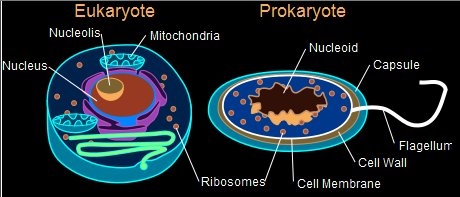Organisms are divided into two groups based on their main cell type: prokaryotes and eukaryotes. Prokaryotes lack membrane-bound cellular compartments like mitochondria and nuclei:
Since mitochondria and chloroplasts contain DNA and the tools needed for protein synthesis, divide independently of the rest of the cell, and are able to carry out vital metabolic processes, it is believed (though not by all) that eukaryotic cells formed through a process called endosymbiosis, in which a cell engulfed another and retained its function.
 Prokaryotes are single-celled organisms, and include two major classifications of life: Bacteria and Archaea. Archaea are involved in the cycling of elements like carbon, nitrogen, and sulfur; they are not human pathogens. Eukaryotes, on the other hand, can exist as single-celled or multi-celled organisms. Members of Eukarya include plants, animals, fungi, protists, etc. Eukaryotes are also the more complex of the three domains of life (Bacteria, Archaea, and Eukarya).
Prokaryotes are single-celled organisms, and include two major classifications of life: Bacteria and Archaea. Archaea are involved in the cycling of elements like carbon, nitrogen, and sulfur; they are not human pathogens. Eukaryotes, on the other hand, can exist as single-celled or multi-celled organisms. Members of Eukarya include plants, animals, fungi, protists, etc. Eukaryotes are also the more complex of the three domains of life (Bacteria, Archaea, and Eukarya).
The identification of eukaryotes in environmental biodiversity studies use 18S ribosomal DNA (rDNA) as a marker. 18S rDNA refers to the genes that encode the RNA of the small ribosomal subunit of eukaryotes. For prokaryotic studies, 16S rDNA/rRNA is used.
 Genomic studies are key to explaining the evolution of eukaryotic cells, and yet, the authors argue, a significant amount of eukaryotic genomes are being largely ignored. Research has been biased towards the study of mutli-cellular eukaryotes and their pathogens, ignoring the potentially genetically-rich single-celled eukaryotes. This bias comes as a result of our very anthropocentric view of life, meaning we are interested in humans and how the natural work harms or benefits us. The "big three" kingdoms of life (Metazoa, or animals, fungi, and embryophyta, or land plants) contain 96% of the described and studied eukaryotic species, and 85% of the sequenced genomes, to-date. Yet they only represent 62% of the available 18S rDNA sequences. The figure on the left describes this bias, as the majority of described species belong to Metazoa, yet significant portions of 18S rDNA belong to protists.
Genomic studies are key to explaining the evolution of eukaryotic cells, and yet, the authors argue, a significant amount of eukaryotic genomes are being largely ignored. Research has been biased towards the study of mutli-cellular eukaryotes and their pathogens, ignoring the potentially genetically-rich single-celled eukaryotes. This bias comes as a result of our very anthropocentric view of life, meaning we are interested in humans and how the natural work harms or benefits us. The "big three" kingdoms of life (Metazoa, or animals, fungi, and embryophyta, or land plants) contain 96% of the described and studied eukaryotic species, and 85% of the sequenced genomes, to-date. Yet they only represent 62% of the available 18S rDNA sequences. The figure on the left describes this bias, as the majority of described species belong to Metazoa, yet significant portions of 18S rDNA belong to protists.
But the study of organisms belonging to the "big three" is also biased. A lot of invertebrates are not as well-studied as bacteria, and species that are most useful for human survival, medicine, and agriculture are more frequently studied. The authors note that this leaves gaps in our understanding of the eukaryotic tree of life, running the risk of neglecting the majority of eukaryotic diversity in future ecological and evolutionary studies. They conclude their article with a call-to-action to the scientific community to fill in the missing parts of the eukaryote phylogenetic tree.

No comments:
Post a Comment